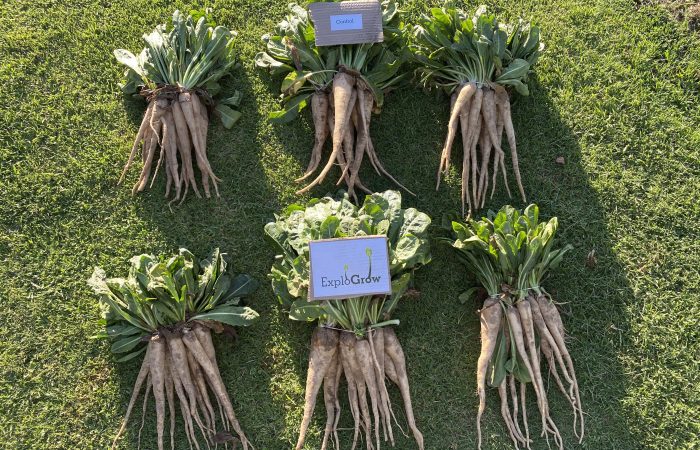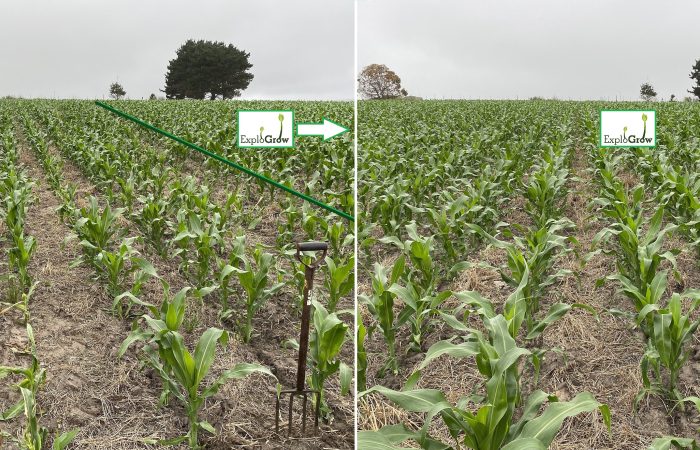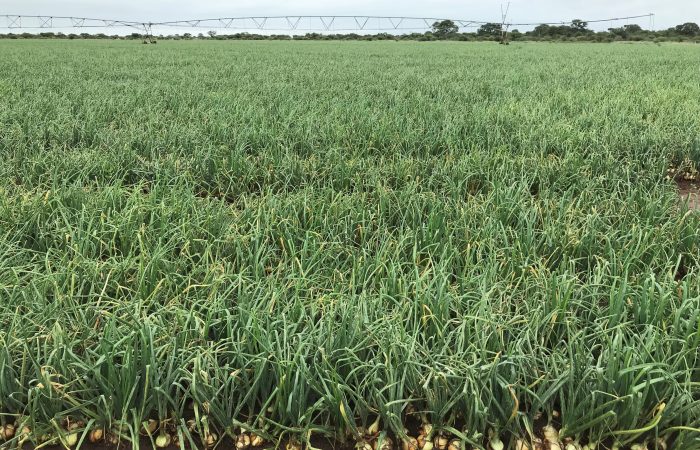Microbial biostimulant seed coating treatment observations on dryland maize +44% root increase and +27% shoot growth
“Leave no seed uncoated!”Izak Van Der Merwe - A leading Maize, Macadamia and Dairy farmer
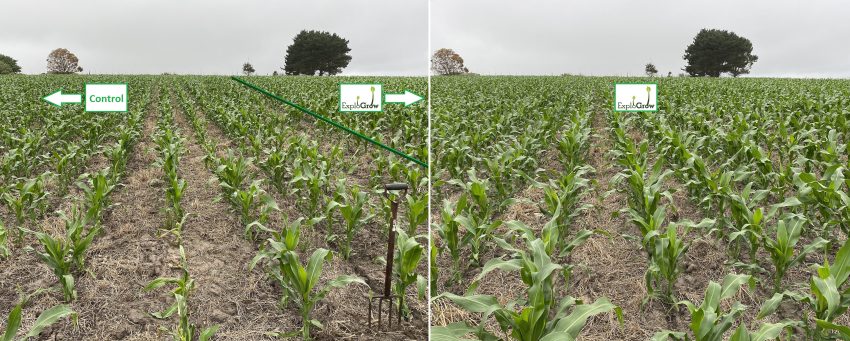
Authors: R. Saunders and B. Willis
Date: 16.11.2020
Title: Bio stimulant seed coating treatment observations on Maize +44% root and +27% shoot growth
- Location: Humansdorp, Eastern Cape, South Africa
- Crop: Dryland maize silage
- 2 litres of ExploGrowTM was applied per ton of seed
- 17ml - 20ml per ha.
- Cost: ZAR 7.74 - ZAR R9.10/ha (US$0.50 - US$0.60/ha)
Maize silage had a dramatic response to a seed treatment with ExploGrowTM poly microbial bio stimulant versus the untreated control area (the control area was also treated with a single strain: Trichoderma harzianum 2x109 spores/gram).
Maize seed treatment observations summarised at V11 stage:
- Total mass: +27.9%
- Roots mass: +44.5%
- Leaf mass: +22.9%
- Ave. No. Leaves: -0.9%
- Circumference of the stem: +9.6%
- Plants per 50m: +5.1% (enhanced germination)
[Note: Stages V11 refers to the 11 leaf stage of the Maize plant, roughly 8 weeks after germination]
Table1. The maize silage seed coating treatment trial
Control | ExploGrowTM |
Thiamethoxam (neonicotinoid) 600g/l | Thiamethoxam (neonicotinoid) 600g/l |
Seed treatment fertilizer mix | Seed treatment fertilizer mix |
Trichoderma harzianum | ExploGrowTM at 2 litres per ton of seed |
The Coating:
Table 1 shows the two treatments used to coat the seed. Both received an insecticide, a plant nutrient seed-treatment, and a microbial treatment. Image 1. Shows the treatment area for these two blocks.

Image 1. Control and ExploGrowTM coating treated blocks.
In-field assessment:
An in-field assessment was done at the V11 stage.
To compare the two scenarios as accurately as possible, the two sample blocks indicated in Image 2. were selected.

Image 2. Map showing the blocks from which the plant samples were taken
After the first plant was measured, the next plant to be measured was five plants and two rows over. Measurements were taken from 20 plants per block (total of 40 plants). Every second plant was dug up to compare the roots and the total plant biomass.
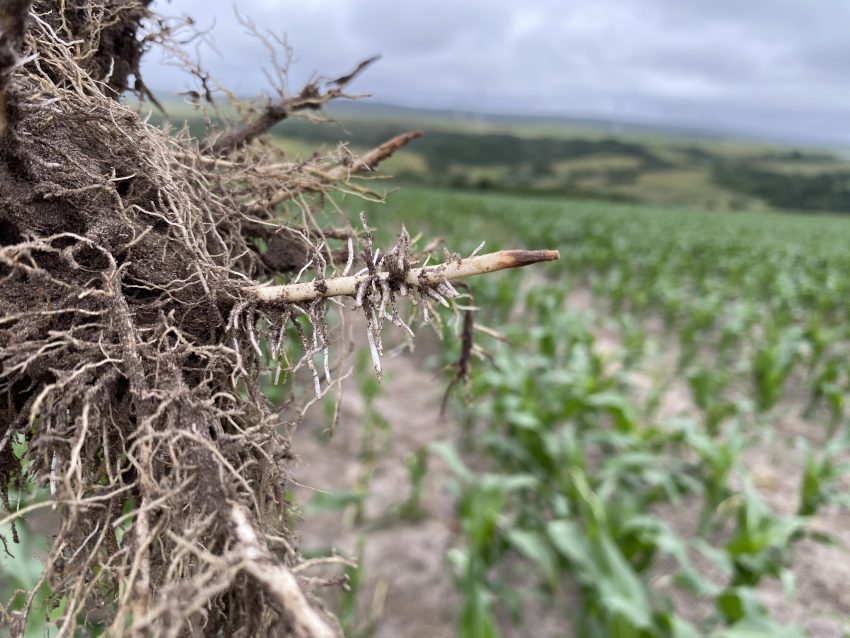
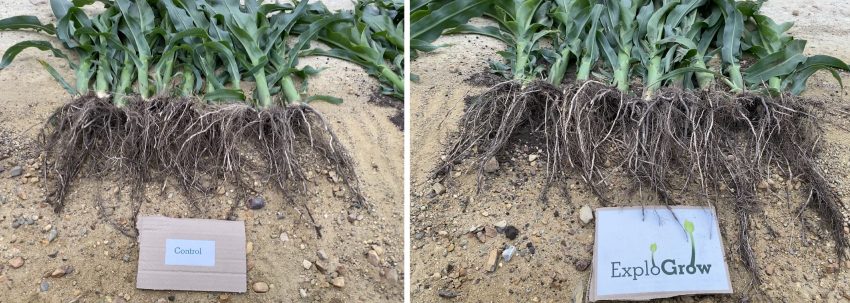
Measurement procedures:
The measurements taken in the field were the following:
- Height 1 (H1): The height from the ground to the tip of the youngest
- Height 2 (H2): The longest leaf was extended vertically above the plant and the height measured from the ground to the tip of this leaf
- Circumference: The circumference of the stem
- Total mass: All 10 plants dug out for each coating treatment were weighed
- Roots mass: The roots from all 10 plants were cut off from the plants, and weighed
- Leaf mass: The leaf mass was calculated by subtracting the root mass from the total mass
- Plants per 50m: The number of plants were counted on a 50m strip of 4 rows per treatment
Table 2. ExploGrowTM vs. Control observations
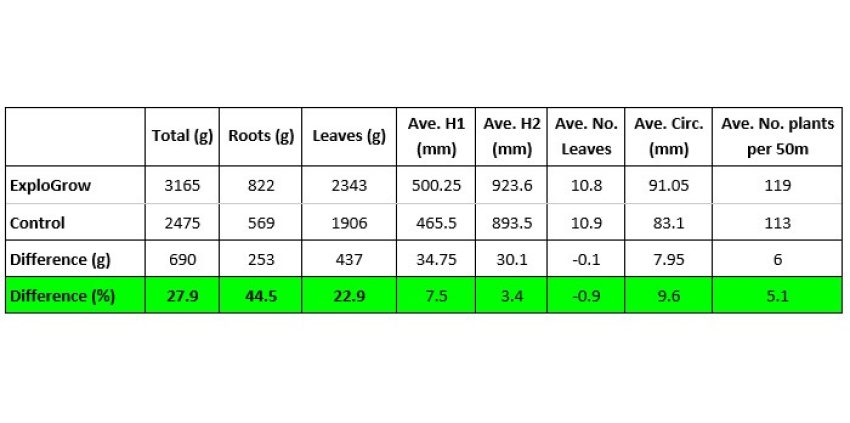
“We’ve never had germination like this” … “In spite of colder than usual soil temperatures this year, we have had outstanding germination on the areas we seed treated with ExploGrow.” Izak Van Der Merwe - A leading Maize, Macadamia and Dairy farmer
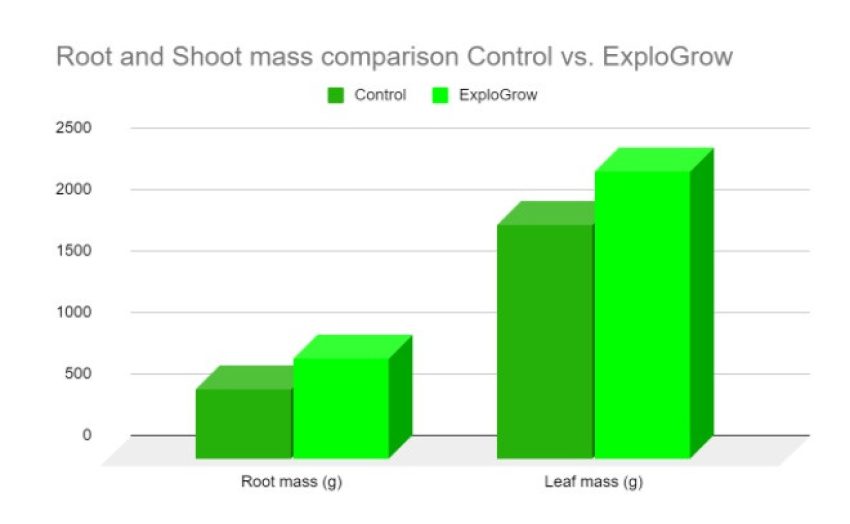
Chart 1. Root and Shoot comparison of the Control plants and ExploGrowTM coating treated plants
Seed treatment with biostimulants: additional information
Single strain versus a complex poly-microbial consortium:
The practice of using microbial inoculants as a seed treatment is commonplace in legume crops.
In recent years seed treatment has been expanded to coating seeds of non-legume plants with biostimulants. Various Trichoderma species are available world wide and their use as a seed treatment seems to be gaining popularity.
ExploGrowTM is a powerful consortium of microbes which contains 4 different species of Trichoderma along with 13 other specific beneficial microbes [complete list here].
Seed treatment with biostimulants according to research:
1. Improved seed germination with biostimulant seed coating treatments
- improved seed germination and germination vigour
- improved shoot and root length
- overall health improved
- production of the plant improved
Microbes have been found to improve seed germination, germination vigour, shoot and root length, overall health and production of the plant. Merriman et al (1974), demonstrated that microorganisms promote seed germination and increased yield in many crop species. Specifically, Bacillus subtilis has been shown to significantly enhance germination and overall growth of the mustard family and several other plant species (Wu et al, 2016).
Recently, the combination of growth promoting microbes has displayed the best germination of paddy seeds (Hanapi et al, 2014). Harman (2000) and Mathre et al (1999), states the potential for biocontrol of soil borne pathogens (Phytophthora spp) by treating seeds with Trichoderma harzianum and Pseudomonas spp. provide an increased level of seed protection through multiple mechanisms.
[References: 5, 6, 15]
2. Improved sprouting with biostimulant seed treatments
ExploGrow™ contains beneficial microbes with systemic functions that have the ability to protect multiple areas of the plant after being applied to the roots or seed.
- sprouting seeds are colonized by beneficial bacteria from the beginning
- defend sprouting seeds from early onset of pathogens
- pathogenic resistance to the leaves
Research from the American Society for Microbiology suggests that plants may pre-inoculate seeds with beneficial microbes in order to guarantee sprouting seeds are colonized by beneficial bacteria from the beginning of the plant’s life cycle. Specifically, Bacillus sp. had the potential to defend sprouting seeds from early onset of pathogens (Science Daily, 2014). Additionally, it has been shown that some beneficial Pseudomonas microbes have systemic functions so they may be applied to the roots and offer pathogenic resistance to the leaves of the plant (Liu et al, 1995).
[References: 1, 9]
3. Improved seedling health, vigour and reduced transplant shock with biostimulant seed treatments
ExploGrow™ contains microbes that can directly and indirectly help plant's ability to handle transplant shock. When transplanting seedlings, the roots can be drenched in a mix of ExploGrow™ in order to increase the number of beneficial bacteria in and around the rhizosphere. These microbes can improve the health of the plant's and the soil environment reducing any physiological side effects of transplant shock, thereby improving potential growth and yield.
- healthier seedlings
- reduce the effects of transplant shock
- more resistance to root rot
- reducing the need for hazardous chemicals
Seedlings are nurtured in an environment different from that of its final destination. Generally seedlings are grown in a sheltered environment offering extra protection from biotic and abiotic stresses like weather, drought and pests etc. When seedlings are removed from their sheltered environment and transplanted into a field or semi protected structure, they are subjected to a degree of stress. This physiological response to stress is described as transplant shock.
Close et al (2005) suggests that it may be possible to reduce the effects of transplant shock through multiple options. Boby and Bagyaraj (2002) show that seedlings treated with Glomus mosseae, Pseudomonas fluorescens and Trichoderma viride in the nursery resulted in healthier seedlings that better handled transplant shock and furthermore displayed more resistance to root rot, reducing the need for hazardous chemicals.
[References: 1, 2]
4. Improved rooting phase with biostimulant seed coating treatments
- positively influence the structure and development of roots
- Nitrogen fixers can directly improve nutrient uptake of the roots
- indirectly influence growth by protecting the plant from harmful pathogens
There are more microorganisms surrounding the roots of plants than there is soil around the roots of plants (Hiltner, 1904). It has been shown that the soil contains an incredible amount of biodiversity from small invertebrates to fungi and bacteria that can not be seen with the naked eye (Fierer and Jackson, 2006). There are bacteria and fungi which can harm the plant and there are bacteria and fungi that are classified as beneficial microbes because of their positive effect and interaction with plants (Glick, 2015).
It has been observed that beneficial microbes can positively influence the structure and development of roots and furthermore significantly improving shoot growth. Nitrogen fixers can directly improve nutrient uptake of the roots and biocontrol agents can indirectly influence growth by protecting the plant from harmful pathogens (Verbon and Lieberman, 2016). ExploGrow™ contains nitrogen fixing microbes (Azotobacter and Bacillus spp.) that can improve nutrient uptake and biocontrol agents (Bacillus, Pseudomonas and Trichoderma spp.) that can protect the plant from harmful pathogens including root rot.
[References: 6, 8, 9, 13 ]
5. Improved plant health with biostimulant seed coating treatments
ExploGrow™ contains microbes which are responsible for performing several functions in the soil having the ability to directly and indirectly influence plant health, improving growth and yield.
ExploGrow™ (soil beneficial microbes) should be applied as early as possible to take full advantage of the benefits the beneficial microbes hold.
- improved stress tolerance
- improved resistance to pathogens
- increased nutrient availability
- improved resistance to root rot
- increased ability to handle transplant shock
- directly or indirectly influence the uptake of nutrients into plants
- supporting the need to reduce fertilizers
Beneficial microbes have the ability to improve plant health through multiple mechanisms. These mechanisms include increased stress tolerance, improved resistance to pathogens and increased nutrient availability (Morrissey et al, 2004).
Seedlings coated with beneficial microbes Glomus, Pseudomonas and Trichoderma showed improved resistance to root rot and increased ability to handle transplant shock (Boby and Bagyaraj, 2002).
Harman (2000), indicates that Trichoderma sp. can directly or indirectly influence the uptake of nutrients into plants further supporting the need to reduce fertilizers. Bacillus and Azotobacter spp. are known as nitrogen fixers that can improve the availability and uptake of nitrogen in plants (Wahyudi, et al, 2011).
[References: 2, 7, 12, 14]
References
1. American Society for Microbiology (2014). Plants prepackage beneficial microbes in their seeds. Science Daily. sciencedaily.com/releases/2014/09/140929180055.htm
2. Boby, V.V., and Bagyaraj, D.J. 2003. Biological control of root-rot of Coleus forskohlii Briq. using microbial inoculants. World Journal of Microbiology and Biotechnology. 19:175-180.
3. Close, D.C., Beadle, C.L., and Brown, P.H. 2005. The physiological basis of containerised tree seedling ‘transplant shock’: a review. Australian Forestry. 68(2):112-120.
4. Fierer, N. and Jackson, R.B. (2006) The diversity and biogeography of soil bacterial communities. Proc. Natl. Acad. Sci. U.S.A. 103, 626–631
5. Hanapi, S.Z., Supari, N., Alam, S,A., Javed, M,A., Jabir Mohd Din, A,R., Tin, L,C., Rashid, S,N,A,A., Annuar, N,A,S., Sarmid, M,R. (2014). Microbial effects on seed germination in Malaysian rice (Oryza sativa L.). Proceedings of the Asia-Pacific Advanced Network. 37:42-51.
6. Glick, B,R. (2015). Beneficial Plant-Bacterial Interactions. Springer Cham. ISBN 978-3-319-13920-3
7. Harman, G.E. (2000). Myths and dogmas of biocontrol. Changes in perception from research on Trichoderma harzianum T-22. Plant Dis. 84(4):377-393.
8. Hiltner, L. (1904) Über neuere Erfahrungen und Probleme auf dem Gebiet der Bodenbackteriologie und unter besonderer Berücksichtigung der Gründüngung und Brache. Arb. Deut. Landwirsch Ges. 98, 59–78 (in German)
9. Liu, L., Kloepper, J. W., and Tuzun, S. (1995). Induction of systemic resistance in cucumber against bacterial angular leaf spot by plant growth-promoting rhizobacteria. Phytopathology 85:843-847.
10. Mathre, D. E., Cook, R. J., and Callan, N. W. (1999). From discovery to use: Traversing the world of commercializing biocontrol agents for plant disease control. Plant Dis. 83:972- 983.
11. Merriman, P.R., Price, R.D., Kollmorgen, J.F. (1974). Effect of seed inoculation with Bacillus subtilis and Streptomyces griseus on the growth of cereals and carrots Australian Journal of Agricultural Research. 25(2):219-226.
12. Morrissey, J,P., Dow, J,M., Mark, G,L., and O’Gara, F. (2004). Are microbes at the root of the solution to world food production. EMBO Rep. 5:922-926.
13. Verbon, E. H., & Liberman, L. M. (2016). Beneficial Microbes Affect Endogenous Mechanisms Controlling Root Development. Trends in Plant Science, 21(3), 218–229.
14. Wahyudi, A,T., Astuti, R,J., Widyawati, A., Meryandini, A., and Nawangsih, A,A. (2011). Characterization of Bacillus sp. strains isolated from rhizosphere of soybean plants for their use as potential plant growth for promoting Rhizobacteria. Journal of Microbiology and Antimicrobials. 3(2):34-40.
15. Wu, Y.N., Feng, Y.L., Paré, P.W., Chen, Y.L., Xu, R., Wu , S., Wang, S.M., Zhao, Q., Li, H.R., Wang, Y.Q., Zhang, J.L. (2016). Beneficial soil microbe promotes seed germination, plant growth and photosynthesis in herbal crop Codonopsis pilosula. Crop and Pasture Science. 67(1):91-98.

